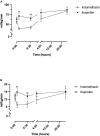Differential effects of ibuprofen and indomethacin on cerebral oxygen kinetics in the very preterm baby
- PMID: 36263147
- PMCID: PMC9574055
- DOI: 10.3389/fped.2022.979112
Differential effects of ibuprofen and indomethacin on cerebral oxygen kinetics in the very preterm baby
Abstract
Background: Ibuprofen is preferred to indomethacin for treatment of a significant patent ductus arteriosus (PDA) in preterm babies despite indomethacin being associated with a lower risk of intraventricular haemorrhage. This difference is thought to relate to the discrepant effects of each medication on cerebral oxygen kinetics yet the effect of ibuprofen on cerebral perfusion is uncertain.
Methods: Forty-eight babies < 30 weeks with a significant PDA, defined by echocardiography, were randomly assigned to either indomethacin or ibuprofen (n = 24 per group) and stratified by gestation and chronologic age. Cerebral blood flow [total internal carotid blood flow (TICF)] and oxygen physiology [oxygen delivery (modCerbDO2) and consumption (modCerbVO2)] were measured using cranial Doppler ultrasound and near-infrared spectroscopy, and cerebral oxygen extraction (cFTOE) calculated, immediately before and following administration. Temporal and treatment related changes were analysed.
Results: A fixed effect of time was seen for TICF (p = 0.03) and therefore modCerbDO2 (p = 0.046) and cFTOE (p = 0.04) for indomethacin alone. In the indomethacin group, TICF and modCerbDO2 fell from baseline to 5 and 30 min respectively (TICF p < 0.01, cDO2 p = 0.01) before increasing from 5 min to 24 h (p < 0.01) and 30 min and 24 h (p < 0.01) timepoints. cFTOE peaked at 30 min (p = 0.02) returning to baseline at 24 h. There was a parallel increase in arterial lactate.
Conclusion: Indomethacin significantly reduces cerebral blood flow soon after administration, resulting in a parallel increase in oxygen extraction and arterial lactate. This implies that the balance of oxygen kinetics at the time of treatment may be critical in very preterm babies with significant PDA.
Keywords: fractional oxygen concentration; ibuprofen; indomethacin; oxygen consumption; oxygen delivery; patent ductus arterious; preterm neonate.
Copyright © 2022 Stark, Crawford, Ziegler, Hall and Andersen.
Conflict of interest statement
The authors declare that the research was conducted in the absence of any commercial or financial relationships that could be construed as a potential conflict of interest.
Figures



References
LinkOut - more resources
Full Text Sources

